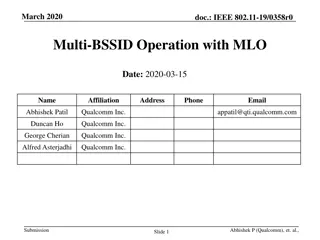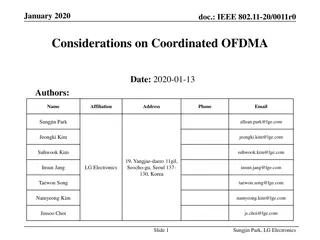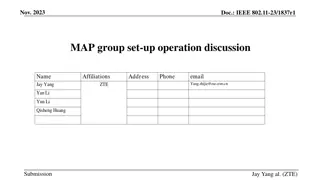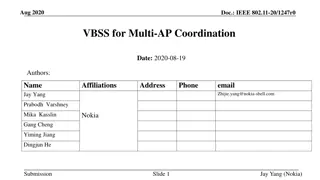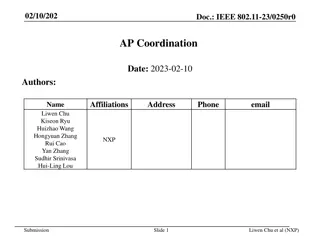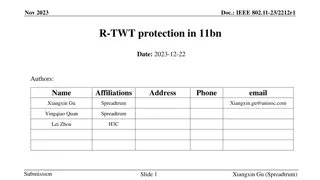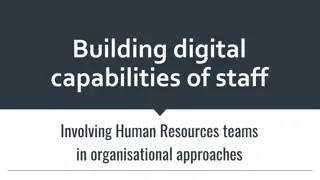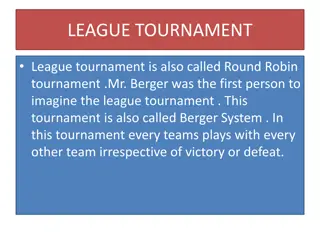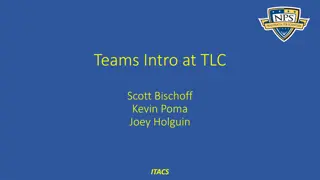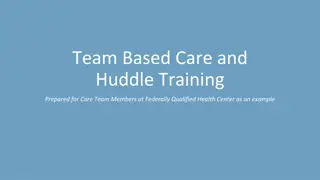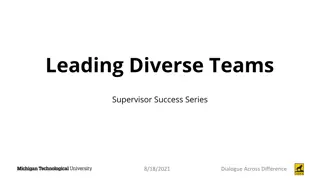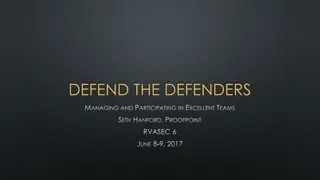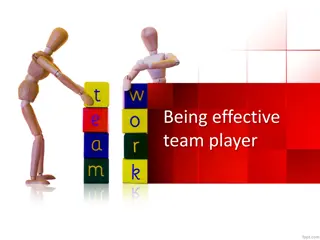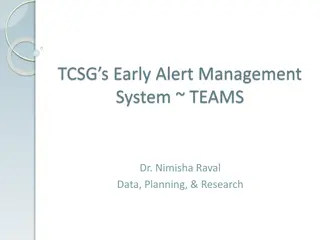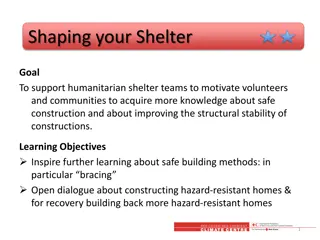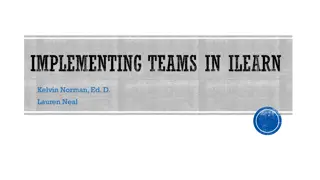Effective APS Teams: Building, Managing, and Strengthening
Learn how to establish and grow effective teams in APS settings through team building, trust-building, communication, and shared responsibilities. This comprehensive guide covers the importance of teamwork, identifying team strengths and weaknesses, utilizing trauma-informed approaches, and fostering a supportive team environment. Explore techniques for creating unified teams, enhancing collaboration, and improving team dynamics for success in APS initiatives.
Download Presentation

Please find below an Image/Link to download the presentation.
The content on the website is provided AS IS for your information and personal use only. It may not be sold, licensed, or shared on other websites without obtaining consent from the author. Download presentation by click this link. If you encounter any issues during the download, it is possible that the publisher has removed the file from their server.
E N D
Presentation Transcript
Building and Managing Effective APS Teams By: Jessica E. Paradee Burke, MPA
Housekeeping for Virtual Platform VIDEO CAMERA MUTE/ POTENTIAL TECHNICAL GLITCHES CHAT BOX EMOJIS AND ICONS IF YOU NEED TO STEP AWAY UNMUTE
Facilitators Name Affiliation
Location of restrooms and emergency exits Cell phones on silent or vibrate Housekeeping for In-Person Materials: Schedule Participant Manual Action Plan 3-hour training
Learning Objectives 1 2 3 4 Explain the importance of teams & teambuilding in APS. Explain how to build & manage healthy, effective teams. Identify strengths & weakness within your team. Explain benefits of using trauma- informed approach to managing teams.
Group Discussion
Groups versus Teams Shared Values Complementary Roles Feelings Expressed Commitment Consistency Trust Conflict Resolution Listening Cooperation Diversity Efficiency Respect Accountability Relationships Unified Purpose GROUP TEAM WEAK STRONG (Leigh & Maynard, 2002)
What is Team Building? The process of bringing individual employees together as a unit; therefore creating a team. Team Building- The Basics Establish your role as a leader Build trust Foster individual relationships Build rapport Build relationships Communicate clearly Establish a vision Set goals Support and respect team members Where do I even start?
Combined Knowledge: Individuals bring their own expertise and perspectives to the team. The Importance of Teams and Teamwork in APS Collective Resources: Individuals access to different resources and helping disciplines. Shared Responsibility: Shared input from team members on complex client situations can be beneficial to all. Support Network: Nobody knows the trials and joys of the job more that our teammates. Teams allow us to feel supported.
Be Transparent Build Trust Keep Your team informed Building Team Strength and Resilience Provide Expertise Praise Successes Embrace Challenges as opportunities to learn Relationships - With individual team members and the team as a whole Build Remain Supportive
Page 7: Journal Entry Have I given my team members the support they have given me?
1. Whereas we all are different and unique, we all share the same profession. Team Team Member Member Buy Buy- -In: In: Shared Shared Qualities Qualities 2. We all want to keep the vulnerable adult population free from maltreatment, neglect, and exploitation. 3. Each of us all has knowledge and skills that are unique and can be combined to collectively assist individuals, groups, and communities. 4. APS work is complex, and resources are limited; therefore, we can be more successful as a team versus working in a silo.
Team Meeting Facilitation Encouraging relationship building within the team Facilitating the meeting as an MDT-case consultation Facilitating Team Meetings
Page 8: Journal Entry How can I make my team meetings productive and inspiring?
Characteristics of Healthy Teams Shared focus and goals Effective communication Diversity Good leader Equal Organization High morale Commitment contribution Clearly defined roles Respect Trust
Characteristics of Teams Characteristics of Teams Unhealthy Cannot express themselves Dysfunctional employee relationships Unaddressed conflict Fear Avoidance of accountability Absence of trust Lack of recognition Toxicity
Page 10: Journal Entry What elements create a positive team experience? What elements create a negative team experience?
Characteristics of Well Characteristics of Well- -Led Teams Led Teams Accepting attitude among team members Inspiring purpose Clear, challenging goals Consistent appreciation and feedback Acknowledgement of team feelings and concerns Leader listens and communicates
Healthy Team Development Healthy Team Development Supervisor s Responsibility Developing a positive group culture Handling conflict between team members Managing the group within the larger work environment
Tuckmans Stages of Group Development Adjourning Performing Norming Storming Forming The Academy for Professional Excellence. (2013). Teambuilding for APS Professionals. Trainer Manual (p.-50-56)
Page 12: Hand-Out Tuckman s Stages of Group Development
Team Team Assessment Assessment Activity Activity
Page 14 Team Assessment Page 15 - My Action Plan
Teams: Taught or Modeled? What are the values that your team leader instilled in you? How did that team leader inspire you?
One size does not fit all Know what motivates each member of your team Intrinsic versus Extrinsic Intrinsic motivation: internal drive and psychological rewards. Feels good helping others Accomplishment Extrinsic motivation: Reward driven behavior Deadline Promotion Praise Money Motivation: Individuals and the Team For Your Improvement (FYI) Unskilled Skilled Overused Skill
Page 18: Hand-Out For Your Improvement: Motivating Others
Page 19: Journal Entry When it comes to motivating others, what am I skilled at? Where could I improve?
Belbins Team Roles Action Shaper Implementer Completer-Finisher Oriented Roles People Coordinator Team worker Resource Investigator Oriented roles Thought Oriented Roles Plant Monitor-Evaluator Specialist
Page 21: Hand-Out Belbin s Team Roles
Challenging Team Members An individual's behavior within the team setting is a function of the group dynamics. Stereotypical Roles: Deviant Member Scapegoat Quiet Member Internal Leader
Challenging Team Members 1.In your small groups, make a list of challenges you have experiences with team members. 2.Choose one challenge to focus on and identify a few options for responding effectively. 3.Small groups will have 15 minutes for their discussion. 4.Reconvene and share ideas with full group. There is worksheet for keeping notes on Page 24 of your Participant Guide.
Trauma, Secondary Trauma, Compassion Fatigue Trauma: a deeply distressing or disturbing experience. Secondary Traumatic Stress: is a lasting or even recurring emotional anguish that results when an individual learns about the firsthand experiences of another person or animal s traumatic experience. Compassion Fatigue : can arguably be described as a stage of trying to cope with repeated exposure to trauma. www.violetaura.com/secondary-traumatic-stress-compassion- fatigue/
Supervisors must assist workers in identifying when they have been exposed to trauma and be available to assist with debriefing it. Always ensure the well-being of the worker Appreciate silence Allow tears and venting Become familiar with Trauma- Informed Practice concepts, research and resources. Trauma-Informed Approaches
Page 26: Hand-Out Trauma-Informed Approach MentalHealth.org
Managing Managing Virtual Teams Virtual Teams
Page 28: Link Ice Breaker Handout Handout-Brain-Breaks-and-Ice- Breakers-for-Virtual-Work- Final.pdf (napsa-now.org)
Transfer of Transfer of Learning Learning To be done on your own time Should take about 30 minutes
Page 30: Hand-Out Transfer of Learning Worksheet with Instructions.
Closing and Evaluations Final Journal Activity Evaluations Thank you for your participation Successful leaders embrace the power of teamwork by tapping into the innate strengths each person brings to the table. The Power of Teamwork Inspired by the Blue Angels




